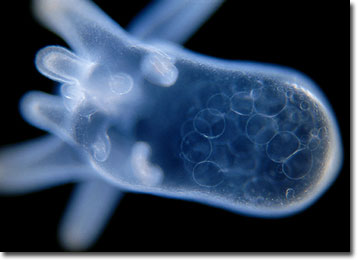Wim van Egmond
Anemone Larva
Though many of the largely sedentary creatures may look like underwater flowers, anemones are invertebrate animals of the order Actinaria. More than 1,000 species of anemones inhabit the seas around the world, but they are most populous and brightly colored in warm waters.

Sea anemones are not colonial animals, but it is not unusual to find large numbers of the same species living closely together. This generally occurs because the organisms often reproduce asexually by lateral fission, small clones emerging from the side of a parent anemone and settling nearby. Interestingly, these clones may actively vie for a plot to settle upon in crowded environments and may kill other anemones, including those of their own species. Extremely competitive, anemone opponents inflate and slap one another with acrorhagi, fighting tentacle-like structures that feature stinging nematocysts. Such confrontations may continue to the death of one of the participants or until both anemones decide to retreat.
Many sea anemones are also capable of reproducing sexually, and the sexes may be either dioecious or hermaphroditic, depending upon species. In the sexual mode, the cnidarians undergo internal fertilization and develop inside the mother. When they are ready for metamorphosis, the larvae swim from the parentís mouth and come to rest on its base, where they remain for protection until they develop tentacles of their own. At this point, they venture away from the parent anemone to settle new areas, where they may live for as long as 65 years.
BACK TO WIM VAN EGMOND GALLERY
